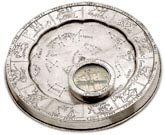The theory that the Chinese invented the compass derives from the legend of the "south-pointing chariot", a machine in which the arm of a humanoid figure always pointed towards South. If we believe this, then the compass appeared as early as 2634 b.C., the year in which the emperor Huang-ti fought and won a battle against rebels making use of these chariots to guide his troops against the enemy through a thick fog. As we should not take this legend too seriously, the first real evidence that the Chinese used the compass to steer their ships is contained in a book entitled P'ing-chou-k'o-t'an which dates back to about the end of the eleventh century a.D.
It has also been thought that the compass was invented by the Arabs (a theory supported by the fact that at that time they enjoyed unchallenged superiority in the scientific field and were highly skilled in the art of navigation), even though other scholars observe that the Arabs, Turks and Persians called the instrument "bossola", a word derived from Italian. This means that the object must have had foreign origins, as did the word used to describe it. Whatever its origins, what is certain is that the first documents concerning the use of compasses for navigation came from China in around 1100 a.D., from the Arab world in the thirteenth century, from Scandinavia in about 1250 and from Europe in around 1187.
It has also been thought that the compass was invented by the Arabs (a theory supported by the fact that at that time they enjoyed unchallenged superiority in the scientific field and were highly skilled in the art of navigation), even though other scholars observe that the Arabs, Turks and Persians called the instrument "bossola", a word derived from Italian. This means that the object must have had foreign origins, as did the word used to describe it. Whatever its origins, what is certain is that the first documents concerning the use of compasses for navigation came from China in around 1100 a.D., from the Arab world in the thirteenth century, from Scandinavia in about 1250 and from Europe in around 1187.




